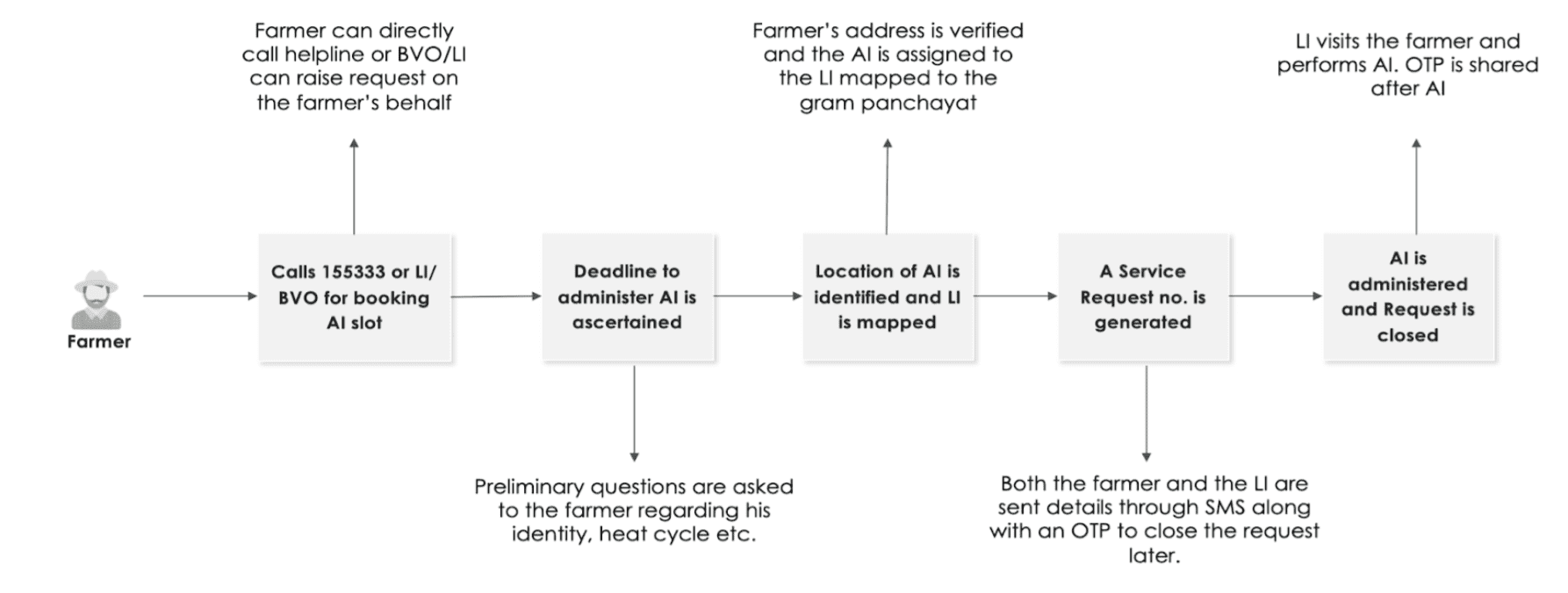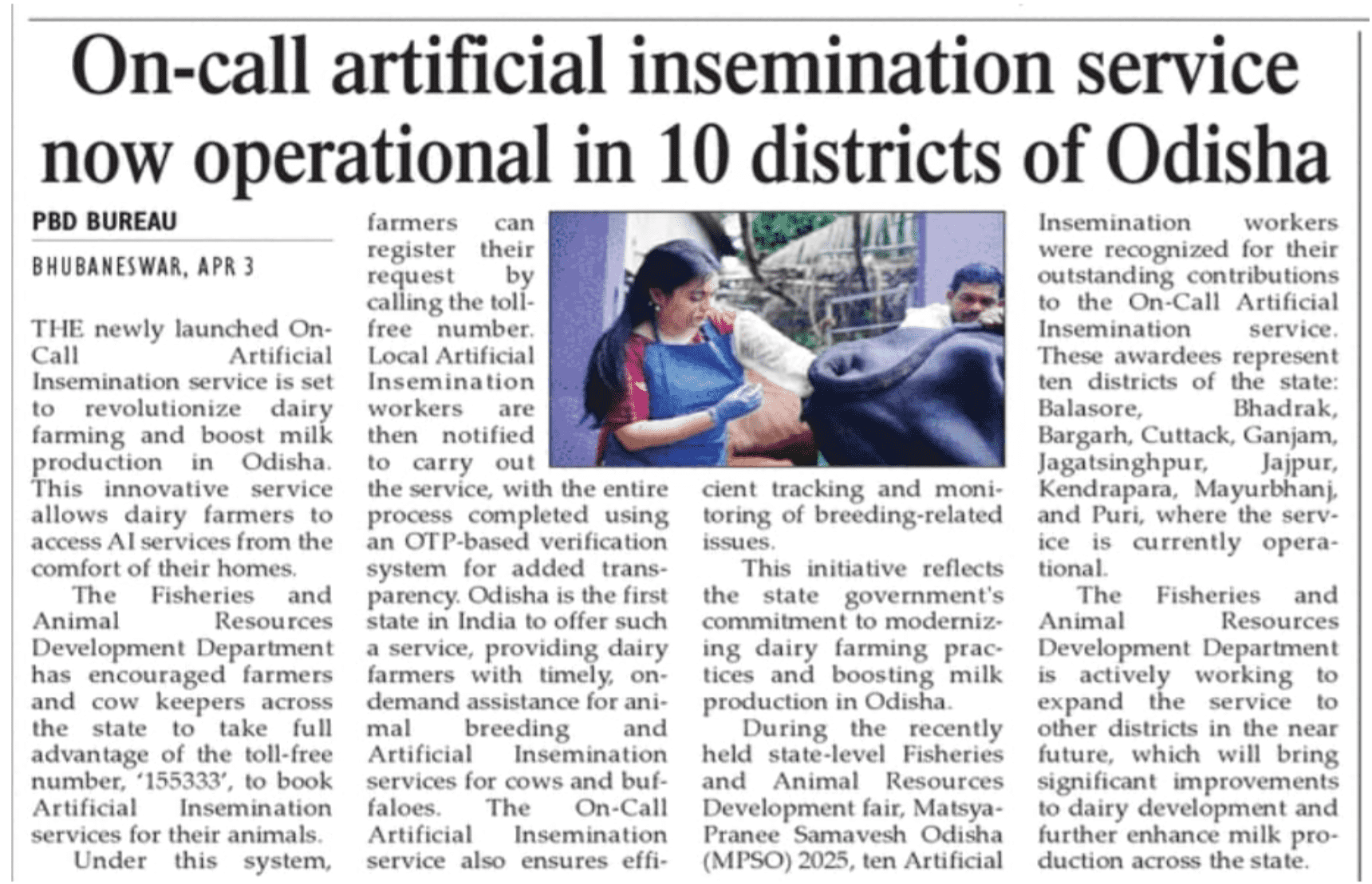The dairy sector is a cornerstone of India’s rural economy, contributing nearly 5% to the national GDP and providing direct employment to over 8 crore farmers. India ranks first in global milk production, accounting for 24% of the world’s supply, with milk output reaching a record 230.58 million tonnes in 2022–23. The country’s per capita milk availability stands at 459 grams per day, far above the global average of 323 grams.
While India leads globally, not all regions are reaping the benefits of this growth equally. Odisha, for instance, has a sizable cattle population of around 1 crore, placing it 10th in the country. However, at an average yield of 3.5 litres per cattle per day, Odisha ranks 25th in cattle productivity in the country. This is primarily due to the low proportion of high milk-yielding crossbred cattle in the state (23% compared to the national average of 37%).
Improving the genetic quality of cattle through breed improvement is key to unlocking long-term sustained growth of the state’s milk production. Artificial Insemination (AI) is a proven breeding technique in cattle, where semen from superior quality bulls is injected to impregnate the cattle by AI Technicians (AITs), leading to birth of high milk yielding progenies. This has been enacted through the National Artificial Insemination Program (NAIP), which became a necessity after the Green Revolution. As agriculture became more mechanised, farmers no longer needed to keep bulls for ploughing, making bull rearing less common. AI therefore solves two problems at once - it helps improve the genetic quality of cattle and addresses the shortage of bulls for breeding.
Yet, the full potential of AI remains untapped due to persistent challenges in how the service is delivered on the ground—an issue that came into sharp focus for Dr. Soumyendra Dhal, a senior official in Odisha’s Fisheries and Animal Resources Development Department.
Dr. Soumyendra Dhal’s Challenge: Poor AI service delivery and administration
Dr. Soumyendra Dhal noticed a troubling gap in the delivery of Artificial Insemination (AI) services. The numbers looked promising to him—1.2 Million+ Artificial Inseminations (AIs) had been recorded annually in the past years in the state of Odisha. By the book, these should have translated into a significant uptick in cross breed cattle population and milk productivity of the state. But the reality on the ground told a very different story. Despite the high number of AIs conducted on the ground, the calf birth rate on-ground was shockingly low, at just 5%. This dissonance between reported data and ground reality was more than a bureaucratic glitch—it hinted at a systemic gap in how one of India’s most important dairy services was being delivered.
Earlier, the administration of AI on cattle was being managed in a decentralized manner in Odisha, with poor traceability leading to lack of data visibility and hence, no proper review and monitoring could be conducted by the Government. This leads to the service being underutilized and inconsistently delivered in Odisha.
It is in this landscape that the On-Call AI service was introduced in Fisheries and Animal Resource Development (F&ARD) Department by Samagra, with support from Gates Foundation — not as a high-tech overhaul, but as a farmer-first redesign of service delivery while enabling centralised service implementation and live monitoring by many officials like Dr. Soumyendra Dhal. What began as a simple helpline-based intervention in one district can now offer valuable insights for transforming dairy service delivery across the state through efficient usage of technology.
Figure 1: Farmer books On-Call AI service by calling Krushi Samruddhi Helpline 155333; verified AI Technician delivers service at doorstep*
On-Call AI Service
Just like how platforms like Urban Company bring essential services such as repairs, renovations, and beauty treatments directly to our doorstep, the On-Call AI model delivers artificial insemination services to dairy farmers in Odisha— on demand, at their convenience, and right at their doorstep.
Farmers who require Artificial Insemination service for their cattle can book it through the state's central helpline, Krushi Samruddhi, by calling the helpline number: 1-55-333. During AI registration, basic farmer details and cattle’s menstruation details are captured by Krushi Samruddhi operators. Based on the cattle's heat period, a deadline is generated for AI delivery. On completion of AI registration, an SMS is triggered to the farmer and the AIT who is mapped to the particular gram panchayat/village of the farmer. Farmer’s residence, contact details, unique ticket id and AI delivery deadline are provided to the AIT in the SMS. Similarly, the farmer is provided with AIT’s contact details and a One Time Password (OTP), which the farmer has to provide to the AIT to ensure assured and timely AI delivery. On the day, the mapped AIT visits the farmer's residence based on the information provided in the SMS and performs the AI on the cattle. On completion of theAI, the farmer gives OTP to the AIT as a confirmation of AI delivery and AIT closes the AI booking.
Through this service, the state aims to build a robust AI service system to ensure efficient tracking and monitoring, systemic transparency and hence provide high quality and timely delivery of AI services to dairy farmers.
Figure 2: Process flow for service delivery of On-Call AI service for dairy farmers in Odisha*
Pilot and Scale up Strategy for Implementation of On-Call AI Service
The On-Call AI service was designed to positively impact a scale of 19 Lakh+ dairy farmers but was implemented through a phase wise pilot and scale up approach. This approach allowed for continuous learning and adaptation, making the service increasingly user-centric and ensuring a strong, sustainable, strategically driven foundation of the service.
Phase 1 of the pilot was launched in Puri district in July 2023, and within six months, the platform received over 17,000 AI bookings, averaging around 110 service requests per day. Encouraged by this response, and based on recommendations from F&ARD Department, the pilot was expanded to nine additional districts — in January 2024. In Phase 2, the service has seen rapid adoption, with over 2.8 lakh AI bookings received to date. The service currently handles an average of 1,000+ bookings per day across the 10 districts, translating to over 100 bookings per district daily.
Additionally, in order to provide motivation to AITs to get onboarded on On-Call AI service, AI related incentive mechanism was also streamlined. Under this initiative, all AITs delivering AI through On-Call AI were provided their incentives on a monthly basis instead of the earlier annual frequency, leading to incentivisation of the AITs.
As the platform continues to evolve, the F&ARD Department aims to scale up On-Call AI service to all 30 districts in Odisha through GO-SUGAM portal, a single platform for all dairy farmers to avail any dairy related schemes and services.
Figure 3: Awareness of On-Call AI service spread through various media channels including newspapers, IVRS, Twitter, Instagram, etc*
Learnings from On-Call AI
The two-year journey of On-Call AI in Odisha has yielded key insights which holds relevance for efficient service delivery in dairy sector :
- Improved Data Transparency: The service currently handles an average of 100 bookings per district daily with a service delivery rate of more than 85% while ensuring same day service delivery. Notably, this demand-driven data contrasts sharply with the historical figures self-reported by AITs which indicated an average of ~200 AIs per day per district. This significant gap suggests a pattern of over-reporting in the past, first noticed by Dr. Soumyendra Dhal as well and underscores the transparency and credibility introduced by the On-Call AI platform. Moreover, while insemination data was being reported historically, the data on pregnancies and calf birth went underreported in the past. Through increased data visibility under On-Call AI service, cattle pregnancy rate has increased from 27% to 50% and calf born rate has increased from 5% to 45%. Notably, the calf birth rate in Odisha under the On-Call AI service aligns with global standards (40%) and surpasses the national average of 8%.
- Scalable design with Pilot Testing Approach: While designing the service strategy, it is critical to develop a focussed solution with minimalistic design which ensures simplicity, resource efficiency and adaptability at scale. While implementing a designed service such as On Call AI, conducting a pilot first enables iterative improvement in the service to build a strong foundation which is sustainable in the increasing complexities of government systems.
- Regular Feedback Incorporation: In order to improve the service continuously and make it more user centric, it is important to remain attentive to critical insights emerging from field implementation and maintain an open channel for feedback from the farmers and AITs. For instance, through field visits and interactions with AITs and farmers, we observed lag in delivery of SMS to farmers and AITs which hindered the successful timely delivery of AIs.
- Taking Stakeholders Along: To ensure long term success of the service and sustained growth in the system, it is essential to align a shared goal with all stakeholders involved and work jointly towards achieving that goal while incorporating regular feedback from them. Under On-Call AI, the value proposition was defined and aligned for each stakeholder: verified & timely service delivery for farmers, timely incentive release for AITs and enhanced data visibility for F&ARD Department.
Conclusion
The success of On-Call AI service demonstrates how minimalistically designed tech-enabled solutions can improve systemic data visibility, enable efficient review and monitoring and thus ensure efficient and transparent AI service delivery in the dairy sector.
For Dr. Saumendra Dhal, what started as a puzzling gap between reported AI numbers and on-ground outcomes became a turning point. The solution wasn’t complex technology—it was a farmer-first approach backed by the right tools.
The On-Call AI model serves as a replicable blueprint for how technology can act as a bridge, not a barrier, to transforming the dairy sector in the country. This initiative exemplifies how simple tech-enabled solutions can create meaningful impact in rural communities, ultimately leading to increased productivity and income for farmers.



